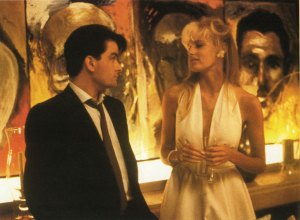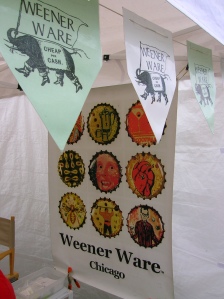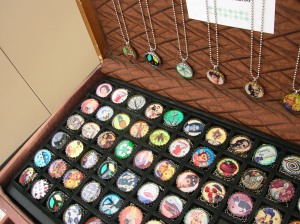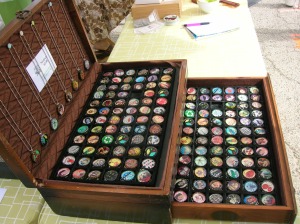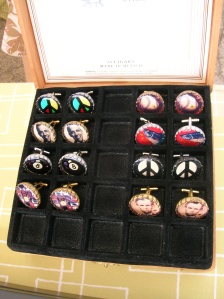Circa Ceramics is Nancy Pizarro and Andy Witt. They have made their livelihoods on transferring images and symbols you wouldn’t necessarily find onto common house wares and ceramic pottery. I think they’re giving more significance to what is traditionally referred to as dishes and cups. Their works are beautiful artifacts gaining in popularity at the art shows in Chicago every year and in my cupboard. Below is an interview I had with them and some photos I took of their studio in the Ravenswood neighborhood in Chicago, IL.
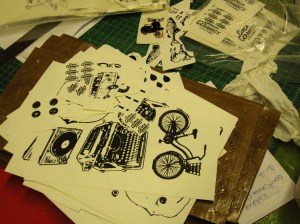
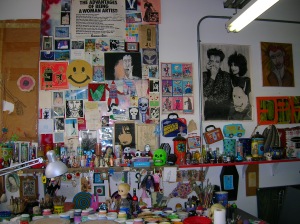
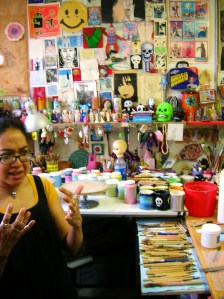
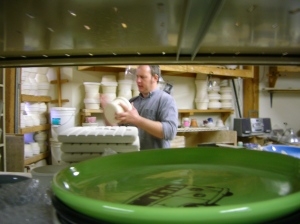
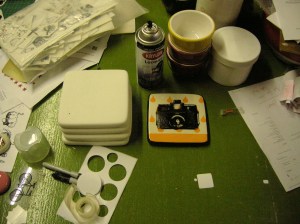
in Develop[ment: The first question I have focuses on the intent of my blog/project. Without revealing too much of the secrets behind your art and trade, can you talk about where your ideas are jotted, organized, referred to when you need them?
Andy Witt: We’re trying to get to a point where we’re acknowledging that we are production pottery. So we need to be able to maintain freshness with new images and slightly vary the colors and have a three dimensional shape to apply these ideas to and the three dimensional shape has to stay relatively standardized, like a painter’s canvas. So we try to introduce a couple of new shapes each year just to keep that fresh but the majority of it is that we just have these blank canvases that we apply these images to and then that kind of develops the creativity from there where we are asking ourselves what kind of themes do we want to go after and what kind of audience do we want to bring in with these images….
Nancy Pizarro: …while still keeping it affordable and attainable to, hopefully, the average consumer. And keep it attractive as well.
i-D: The images that you use…are they pulled from different places or do you keep a cache of images on hand or a folder of images?
NP: Yeah yeah it’s a lot of that. I have collections from catalogs over the years.
AW: Well basically all the images are stored on the computer because we have to print them out in a transparency to be able to silk screen them. So Nancy has the images in various states of completedness
NP: (Nancy laughs knowingly) IT TAKES TIME
AW: A lot of the times we’ll be at the computer researching a theme like “survivor horror video game series.” So I’ll start doing Google image searches on pick axes and lead pipes and
NP: First-aid kits…
AW: Then I’ll have a collection of raw photographs that need to be converted into Photoshop…
NP: …to try to make them print-friendly. For screen printing usually you need a high contrast with definite sharp edges.
AW: Yeah, we have a camera series where we take old camera images and basically turn them into clip art and we’ve found that photographers take really nice pictures of their cameras. But then when we try to do something like a 4-wheel drive monster truck series and the quality of the image really goes down…(laughter)…because the person taking the picture will crop it in a way that the front half of the truck is missing…but you see the tires.
i-D: right right well the tires are important to monster trucks.
AW: So we really do rely on the person taking the photograph.
NP: We do have customers that are very very kind and will allow us to use their imagery that they’ve sent us for custom screenings but they do fall into that category where they would chop off important things like the tires because “you really don’t need those.”
AW: Or there’s a cat on the hood. And then there’s two hours just trying to remove the cat. But we will occasionally resort back to our art school training to complete images by drawing in missing elements by hand to make the image work.
i-D: So you do sometimes make your own images?
NP: If I really want to sit down and do it I’ll do it. But most of the time we have so many different things going on at the same time I never have enough time to actually sit down to make two or three images. I LOVE to do it but I don’t have time.
AW: But it also brings up the question of what’s the difference between hand drawing something or using a tool like Photoshop to manipulate the image and I think the art festivals are finally getting into the understanding that it is a skill to use Photoshop. It’s not this evil tool that makes everything simple.
i-D: In a lot of imagery, like the Obama campaign icon, the artist [Shepard Fairey] got into legal trouble because he used an Associated Press photo but has argued that he actually conformed to copyright law because he manipulated the photo and made it his own. So I was curious about your process in this respect.
AW: We pretty much claim ignorance. Well in the instance of a big company like Vespa Scooters or…
NP: …or the Sanford Pencil sharpener company where I have actually encountered people from the company who get a big kick out of seeing this pencil sharpener that they still make on our pottery. It’s just one of those things where they look at it as…
AW: …public domain
NP: …well no it’s not even that. It’s that we’ve taken such a simple tool and moved it to art status. It’s no longer a pencil sharpener it’s an icon that invokes school or…
AW: …childhood memories.
i-D: You are really attracted to the mundane things found in classic homes in your imagery; old appliances, typewriters, cameras, even automobiles. How do you look at their modern counterparts? Or modernity as a whole?
NP: I like to think that these are the objects that we tend to forget about every day. They’re like shoes or running water. Really basic things. I like the idea of being able to, I don’t want to say elevate them, but almost turning them into icons like saints in Catholicism. Each one has its own little power in its setting.
AW: I don’t really care for a lot of the I-products because I think there’s such a lack of design in their simplification. It tends to look really dated after about a year or so but it forces you to buy a new product after the coolness factor wears out. That really bothers me. It’s really a gross aspect of today’s market. It’s more fashion…the term fashion. With these older products, they’ve withstood the test of time. Whereas these newer products, it’s really hard to see how anyone would use them in ten years. Most of them won’t even be working in less than five years.
i-D: That’s what makes those older products classic.
AW: I kind of hope that our pottery hearkens back to a pre-World War II mind set where things are more…
NP: …substantial and hearty.
AW: Yeah and where there wasn’t that much of a disposable mentality.
NP: That’s really how we came up with our logo. When we started we looked at other pieces and flipped them over to see where they were made.
AW: I think it was really accidental that the Circa name fit so well with the “circa” in the images. It was not a conscious choice. And we’re not the only ones who use this type of imagery. For example, some T-shirt producers.
NP: They are other table ware producers, like us, that are small scale that do use everyday objects in a silk-screen process like ours. But I’d like to think that our ware is…well…much more substantial than their ware.
i-D: I have noticed that you have tended to develop your designs into more silk screened images and steered away from the floral patterns of your earlier work. Was this a conscious choice, by customer demand, or more of an organic process?
AW: A little bit of everything…one of the things we found out is that it takes so much underglaze which is the pigment that those images are painted on and it is very expensive. So when you coat the entire surface it starts adding up—the money we spend to stock the pigments. And some of the pigments don’t work very well so we end up layering these colors. Also one pigment might be one color in June and then when we buy it again in August it’s slightly changed and it throws off the whole…
NP: …it’s the consistency. Underglaze consistency is an issue. The actual glaze was an issue at times as well. Basically, I was painting all of these pieces and it was losing its fun factor. It was becoming a chore. I started to dread coming to the studio and painting these pieces. I felt like a lot of our customers were taking advantage of our flexibility with, for instance, some of the background colors. Or asking for certain types of layouts with designs that were already laid out a certain way. I really was not looking forward to painting them anymore.
i-D: When it ceases to be fun that is a good way to change.
NP: Totally! Our customer base started to change a little bit.
AW: The major change is when we switched from the earthenware to the porcelain. When we started with the higher firing porcelain we lost a lot of our colors.
NP: That was by force. Our color palette completely changed and became more simplified. You’ve got your core primaries and then you had a few secondaries but tertiaries were non-existent. It really forced you to focus on what you were doing with the design. I simplified everything. Just the color set-ups. I went from 10-11 color set ups down to two. It cut back on a lot of the labor but the quality of the work was better and the durability was there.
i-D: That does bring me to my next question. Back in the nineties I remember seeing a lot of those pottery cafes where you spend the day painting the form and they put it in a kiln and you spend an exorbitant amount of money for that piece that you designed. I was curious about your thoughts and how you see Circa Ceramics within this genre because it is something that many people remember?
AW: When we started, as a means to boost production, we purchased a lot of those pre-made forms but we would paint and fire them ourselves. Then, if we were doing a show in the suburbs we would get kids coming into our booth and say, “Oh I have a platter just like that.” And the dad would lean to the daughter and say “well this is just like what you do.” They didn’t even see the quality of the painting.
NP: All they saw was the form.
AW: The form and the color and the bright shiny glaze. We would also see 18-30 year-old women come in and just absorb and think that they could go back and just paint our patterns. We would ask if they were going to purchase a piece and get the response, “no I’m just going to absorb the images for a while before I go to pottery class on Thursday.” They would spend more money trying to paint it themselves and without buying a piece they’re not going to be able to recreate it. Now, we don’t get that so much because people don’t have any idea of the involved process. They don’t want to learn how to silk-screen. They don’t want to learn how to fire at hotter temperatures. The whole paint-it-yourself pottery studios are on their last legs I think.
NP: It’s kind of sad.
i-D: So you do see that as a sad thing.
AW: It’s sad because back in the eighties there was the mom-and-pop pottery store where they would make slip cast greenware and the commercial manufacturing companies where they would make the underglaze and make the glaze, they would support these mom-and-pop operations. People would come in and paint the greenware and they would fire it. Then all of a sudden the commercial manufacturing companies shifted and started promoting the idea of paint-it-yourself pottery studios and they would send out these kits along with a booklet on how to create your own business. Well this, sort of, forced out the mom-and-pop pottery stores. There was this gross transition of about four years where you would see vacant spaces and Going-Out-Of-Business signs and truckloads of slip casting molds going for a dollar a piece or haul ‘em and have ‘em “sales.”
NP: I see it as sad because anyone who wanted to, I hate this phrase, “play with clay” would be put off by the more traditional pottery studios where people would have the university or college education behind the craft. They see these places as intimidating and that would quash any interest that they had because they have nowhere to go that has a casual experimental environment and not feel that pressure from more educated potters.
i-D: In referring to your own education, can you talk about how your first ideas evolved into something you knew were going to provide you with a living or was that always the goal?
NP: We both went to Columbia College. I was a more traditional portrait painter. That was what I studied. Andy was into sculpture, kind of in the ceramics media.
AW: Yeah but it was shifting into mold making and using clay as a means to do metal casting and cement sculpture. But it was always a priority to have a studio space. When we moved to New Mexico we made sure our apt had 400 sq ft space to create even though it was used as storage for a good year. I don’t know if we ever really knew if we could make a living off of our art. It was more of, “can we make this work.” A lot of our base ideas for pottery came from when we were working at a production pottery studio in New Mexico.
NP: A very large production studio in Albuquerque, Kelly Joe Designs. I was lucky enough to get a job as a painter and my being bi-lingual helped me a ton because I could retain my position and do studio managerial tasks like placing orders or training some of the new painters for bigger projects. It was a very interesting time for both of us.
AW: Yes, I got to do free-lance mold making. Kelly would go out and purchase a wooden bowl and I would make a mold of it and then make a master mold of that and then make production molds so I was making money on the side and learning mold making. At the time I didn’t know how to do slip casting or making pottery at all it was just strictly plaster work. It was about 1998 or 1999 when we started getting our own shapes together and making molds. I think we made about 8 bowls and we were going to sell them at a flea market to make the money to pay for our trip back to Chicago.
NP: We couldn’t wait to get out of Albuquerque. I’m sorry ABQ (laughing)
AW: It was pathetic.
NP: It was a good lesson.
AW: The patterns…
NP: Oh the patterns. Just coming up with eight different looking pieces. That was a challenge.
AW: And I’m coming from a field where everything had to be earthy. I’m trying to pit fire in the backyard in downtown Albuquerque. Trying to do blackware.
NP: Trying to hide it from our landlord.
AW: That was really strange.
i-D: So when you did get back to Chicago was there a specific moment that it dawned on you that this was going to be a business or was it more of a longer struggle?
AW: I think we were just half-assing it. [To Nancy] Did we have the small kiln when we did Queen of Angels?
NP: We did have a small kiln. I remember we were dabbling. I had a lot of pieces…Kelly Joe if you happen to read this I’m really sorry. I had a lot of pieces that I brought home with me and I had never painted because at the time in Albuquerque I had enough supplies at home that I could take the pieces home to paint. So when we left for Chicago, instead of breaking everything I told Andy I wanted to bring them with me. So we packed all of this greenware as safely as possible. That’s what we started with along with some limited supplies. We made gifts for people when we came back to just play around with it.
AW: So we were here for just over a year and we found a show just down the street at a Catholic School, Queen of Angels. It was like $40.00…
NP: For an eight foot table. It was very quaint.
AW: We set up a bunch of stuff and we sold out of almost all of it because it was so dirt cheap.
NP: It was dirt cheap but also, I was crazy painting back then. I had five clip art books and I was obsessed with oriental tapestries at the time. So I replicated them by hand on these bowls and sold them for $15.00. People were saying it was a steal for 15 bucks! Of course, that bowl now, with a tenth of that design, is $60.00.
AW: But you can’t say that because the quality of the glaze, the quality of the ware itself, and we’ve grown and that growth itself is what drives the price.
NP: But from a painter’s stand-point that bowl should’ve been way more.
AW: Yeah, but that price is also driven by who you are and what you’ve done in the past. It really upsets me when I see artists that jump onto the scene and then start doubling their prices and the quality is not following that increase in price. It’s not bad to sell your pieces at rock bottom prices to figure out the industry. I don’t think that’s a bad thing.
i-D: Your studio is something that most artists strive for, that is, a space outside the home sanctuary to create and deal with the business of your art. The space is more of a necessity for your work with the kiln, burning things, mess, etc. Aside from the necessity, I would like to know how this space has affected your everyday life. Specifically, is there a good balance between work and home?
AW: When we moved back to Chicago, we wanted to have a studio space and we lucked out. A friend knew of someone who was moving out of a studio space. It was a 1200 sq ft converted doctor’s office. There were a series of small 12 x 12 ft rooms that we could allocate different methods of production. And then there was a living room and bedroom. But the studio still bled into everything and you couldn’t really get away from it. Luckily we had three phase industrial power but in our second or third year we bought a larger kiln that used 48 amps of electricity that required new wires. So, without our landlord knowing we were doing this, we installed this kiln which took up the entire back room. Our place was about 100ft long and 15ft wide. We would fire this thing and about at the 50ft line there would be this wall of heat coming from the back room.
NP: It was pretty awesome.
AW: What would suck is that the place was on the second floor so we had to walk everything up and down the stairs. So when we decided to move the business to a separate studio space. I think I was on the toilet when I said, “Hey Nancy what about this?” We just did it. We started looking at spaces and within a month we were moving in. We really lucked out with the studio here in Ravenswood because so many spaces were just so horrifying. This space had brand new electrical service.
NP: Newly rehabbed.
AW: Access to the alley which made everything so easy.
i-D: So getting to your daily schedule…as you look in shock especially after a weekend like Wells Street Art Fair. Do you limit the time in the studio? Do you punch out?
AW: Well, we started to make a decision this year, we tried to do it last year, where we would say, “Fuck it, it’s not going to get done. We’re going to kill ourselves if we go on. If it doesn’t get done we’ll have it for the next show.” We’re not trying to do the all-nighter. Even with Wells Street this year, I think we got about four hours of sleep?
NP: Yeah that’s pretty good.
AW: Usually with Wells we would do an all-nighter and then the next morning we would end up losing money because we would be so out of it and couldn’t deal with the customers…
NP: …and couldn’t remember who came into your booth on Sunday. Which is so bad.
AW: We’re trying to limit that but there’s still a huge to-do list and not enough hours in the day. In the winter, we were doing around eight hour days so that was pretty light.
NP: We still haven’t taken any legitimate days off though.
AW: No.
(Nancy laughs immediately)
NP: We try. We do half days. We know we need the time off so we make ourselves leave.
AW: Or we come in later.
NP: Yeah, we try to do a leisure morning at home. But even then we’re still working! We’re on our laptop researching, checking emails, on the website, etc.
AW: When you’re self-employed these days though, twitter is…not for fun.
i-D: In following the theme of creating a set schedule for yourself, I know there are many technical rules that you have to follow in your medium but I also wanted to know what sort of rules in creating your art you have developed over the years.
AW: I would say we have a ton of rules. They’re mostly unwritten. A lot times we bounce ideas off each other like how perverted can we go with an image. Where’s the boundary of taste? Or where’s the boundary of social acceptance? When does an image start to make fun of the people we’re trying to sell to? Most of the time we don’t follow through.
NP: Usually these ideas come from times when we’re at the computer and then one of us would come up with something saying, “Wouldn’t that be so sick to do that?” And then we play with it for a while talking it through. So we say it just to say it then it just goes away.
i-D: I’m kind of half-expecting to find a cupboard of perverted pottery.
(Andy and Nancy both laugh)
AW: Well, one of the rules is that we don’t do anything political.
NP: Yeah. Although the Chicago flag is a little political.
AW: But how is it political?
NP: Well, it’s your alliance to a city.
i-D: I’ve seen that image tattooed on many different people I don’t think it’s political.
NP: (laughing) Okay well then we’ll take it out of the political realm.
AW: We try to be family friendly to a certain extent. We hold our customer in high esteem. We want them to love the work. We want them to be able to display the work.
NP: We want them to use it. But we also know what we like. I like skulls and I will always have skulls as a theme. So there’s our background that comes into it and our education.
AW: There are also rules about what constitutes a second and will we sell a second.
NP: Oh yeah, that’s always a big issue.
i-D: Can you explain what a second is…
AW: A piece of pottery that just doesn’t cut it. For a while we had images where the black was bubbling on the surface when it came out of the kiln. We wouldn’t sell those pieces. But it was really frustrating when we would do hand painted pieces and a gas bubble would come out of the clay body during the process, even though it would heal itself, it would still have a discolored memory of the bubble on the piece. The glaze would be totally smooth otherwise. We would have a customer pick up a piece and point to that mark and ask for $5 off of a $15 piece. That did not constitute a second. You really just have to live with marks like that due to the very nature of pottery.
i-D: So that rule, what would constitute a second, would be very limiting.
AW: If a piece is severely warped that would be obvious. But it’s more of an intuitive process. You have to ask yourself would you pay full price for that piece. Or how obvious is that flaw. But in our line we have set it up where the seconds would be identified so they would not go to the final stage of image application. So there we would save ourselves the extra time…
NP: …and the extra expense.
AW: A lot of the times if a piece did have that small bubble mark out of the kiln we could cover it up with the image application. I don’t think we’re hurting anybody by doing that.
NP: Another rule that we have is that we don’t talk shit about other potters in public. We’ve seen other potters that we respect and go to their blogs or get their tweets and they would be talking about other potters or their customers. It…it’s one of those things where you know that’s going to come around to bite them in the ass. Just let it go. Vent in your private area on your own but not in public because that stuff is never going to go away.
AW: And there’s a history.
i-D: That is the nature of these blogs. It’s so personal that people often forget about the very public arena of the web. So do you find your rule about not talking ill inhibiting?
NP: In a way. Because sometimes when we read something we’ll wonder if they are referring to us.
AW: It’s probably breaking my rule but when we started out using manufactured pieces but painting them ourselves or using molds that we made ourselves we would always run into the “no molds allowed in this art festival.” We would always get shit from other potters like “do you even know how to formulate a glaze?” Or “I would never want to sit and run a machine all day.” But these comments are coming from people who are teaching art to children. They’re not full-time potters. I want to work in ceramics. I don’t want to teach pottery. We came up against a lot of dogmas. We thought at around 2005 or 2006 we came out of that “mold making is bad” or “production is bad” attitude, but then we went onto Etsy.com.
NP: Where their tagline is “Your place for all things handmade.”
AW: And we would get slapped again with the same dogmas from the past. We thought we went back in time five years. It’s really frustrating to see how potters would limit themselves for their own self-righteousness. I would like to point those people out on my blog but I refuse. It’s like airing dirty laundry.
i-D: Well I didn’t want to leave the interview on this note (laughing). I’ve got one more question. What one symbol can describe your career so far?
AW: The upside-down cross.
NP: (to Andy) Stop it!
AW: Something in our work?
i-D: It could be anything.
AW: Our van because that was the dumbest thing we did is when we bought that van.
NP: I love our van though. Though most people do know us by our van. It’s really scary. It turned into part of our logo so I put it on as many things as possible.
AW: Although I don’t think we live up to the whole Henry Rollins credo “get in the van.” We’re not touring the entire country. Sometimes we barely make it to the south side of Chicago.
i-D: I like the image of the Van…but that’s more like leading the question. 
NP: (laughing) Stop it stop it. Yeah, well it does take us places. We went to Baltimore in it.
AW: It did make us work a hell of a lot harder.
__________________________________________________________________
Shop Circa’s Etsy site here:
http://www.etsy.com/shop/CircaCeramics
Read Circa’s Blog site here:
http://circaceramics.blogspot.com/
 There’s a part of my brain that jerks my consciousness into an odd awareness every April. That odd awareness is National Poetry Month. I don’t know why the nation needs a month dedicated to poetry. It continually ignores the medium the entire year, why should the month of April be any different. Yet every left-leaning-scholarly-intellectual news source has to have a segment on poetry in the month of April. Since I am a poet (albeit a very occasional one) this spotlight on my medium of choice (and torture) frustrates me as much as it pleases me. So, in the tradition of those snooty news sources, In Develop[ment (which is me) will provide some poetry for you, whether you’ve asked for it or not. And in protest to all poets who “give over the poem to the readers’ interpretation” I will explicitly give you the meaning of the poem and tell you not to take it for anything other than what I say it is. My promise/challenge is this; since we are about half way through National Poetry Month I will TRY to eke out a poem a day until the month is over. Come May you can go back to not reading poetry until next April. Deal?
There’s a part of my brain that jerks my consciousness into an odd awareness every April. That odd awareness is National Poetry Month. I don’t know why the nation needs a month dedicated to poetry. It continually ignores the medium the entire year, why should the month of April be any different. Yet every left-leaning-scholarly-intellectual news source has to have a segment on poetry in the month of April. Since I am a poet (albeit a very occasional one) this spotlight on my medium of choice (and torture) frustrates me as much as it pleases me. So, in the tradition of those snooty news sources, In Develop[ment (which is me) will provide some poetry for you, whether you’ve asked for it or not. And in protest to all poets who “give over the poem to the readers’ interpretation” I will explicitly give you the meaning of the poem and tell you not to take it for anything other than what I say it is. My promise/challenge is this; since we are about half way through National Poetry Month I will TRY to eke out a poem a day until the month is over. Come May you can go back to not reading poetry until next April. Deal? does in writing what boxers do in the ring, beat the crap out of a guy while putting on a very elaborate show. Mamet is most famous for writing “Glengarry Glen Ross.” Seven minutes of that film gave the salesman speech, which had lagged ever since Miller’s Willy Loman skulked onto the American stage, a much needed punch in the gut. Mamet directed many con/heist/crime job films, my favorite genre, and has the smartest sense of timing. The crime-speak language between the characters in these films acknowledges that the movie-going audience is smart but will always fall for anything in a short skirt. For examples rent House of Games, The Spanish Prisoner, and Heist.
does in writing what boxers do in the ring, beat the crap out of a guy while putting on a very elaborate show. Mamet is most famous for writing “Glengarry Glen Ross.” Seven minutes of that film gave the salesman speech, which had lagged ever since Miller’s Willy Loman skulked onto the American stage, a much needed punch in the gut. Mamet directed many con/heist/crime job films, my favorite genre, and has the smartest sense of timing. The crime-speak language between the characters in these films acknowledges that the movie-going audience is smart but will always fall for anything in a short skirt. For examples rent House of Games, The Spanish Prisoner, and Heist.

